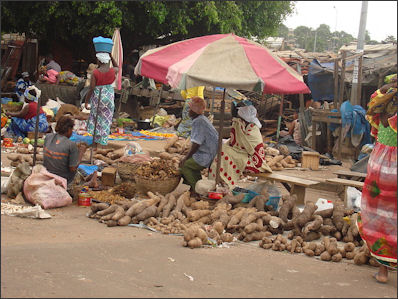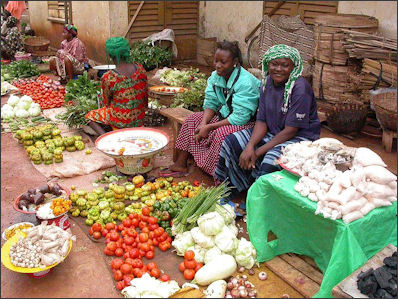GLOBAL FOOD CRISIS IN 2008
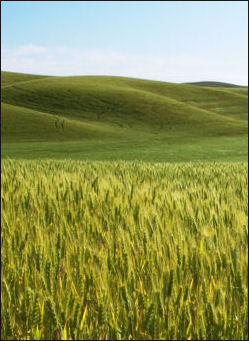
In 2008 food prices soared to such high levels that a global food crisis was declared. Between 2005 and the spring and summer of 2008 corn and wheat prices tripled and rice prices increased five-fold to $1,080 a ton. The price of all three grains soared 50 percent in just a few months. The prices of other commodities like soy beans, barley, canola and sunflowers seeds also rose sharply. The crisis threatened to plunge more than 100 million people into extreme poverty. What was perhaps most remarkable about the crisis was that it occurred at a time when many places were recording record grain harvests.
There were food riots in nearly two dozen countries, including Mexico, Burkina Faso, Senegal, and Morocco. The riots in Egypt, where wholesale rice prices doubled, were the worst in a generation. In Thailand and Pakistan troops were ordered to protect crops. In Haiti, people at made pies comprised of cooking oil, pits of vegetables and dirt and toppled the government.
In the Philippines people went hungry because they couldn’t afford rice, which tripled in price in a matter of months. Prices rose for cooking oil in Malaysia and for beer in Munich. India and Vietnam cut off exports of rice. In the United States, bagels and eggs increased in price by 30 percent and bread prices increased 50 percent. Worldwide the prices of meat and milk went up as grain that would have normally been used for animal feed went to make biofuels instead.
The World Food Program said the crisis put a heavy burden on the world’s 1 billion very poor, who spend between 50 and 70 percent of their income on food. Some said the crisis increased the number of world’s poorest poor from 1 billion to 2 billion. In developing countries food was scarce then it was available but too expensive for most people to buy. The cost of a 50 percent price rise on basic food stuffs can be devastating to the very poor, who often live on $1 or $2 a day. A doubling or tripling of prices can be catastrophic.
High Food Prices in 2010 and 2011
Rising food prices became highly sensitive issue in 2011 around the world after fueling protests that toppled the rulers of Tunisia and Egypt earlier this year, with unrest spreading across North Africa and the Middle East.
Wheat prices suddenly rose 70 percent above normal levels in the summer of 2010 as the worst drought in decades devastated crops in the Black Sea region. Price then remained high into 2011. Prices for corn have more than doubled in 2010 months with global production unable to keep pace with record demand driven partly by the growth of the U.S. ethanol industry.
In September 2010, the Rome-based Food and Agriculture Organizationed reported that cereal production this year was the third-highest ever recorded, despite a drought-fueled wheat shortfall in Russia, and cereal stocks were high — some 100 million tons more than the low levels of 2007-2008, when some 38 countries shut down their food export markets in reaction. Increased demand for biofuels and soaring petroleum prices took much of the blame for the spiraling upward prices then. Food prices are still "stubbornly" high, but "we haven't seen the type of behavior .... panic buying" that helped feed the speculation and fears of a couple of years ago, said Josette Sheeran, the executive director of the U.N. World Food Program. [Source: Frances D'emilio, Associated Press, September 14, 2010]
The United Nations reported in April 2011 that food prices were just below record highs after 8 months of rises and in March warned that further oil price spikes and stockpiling by importers keen to head off unrest would hit volatile cereal markets.
Causes and Results of the Global Food Crisis in 2008
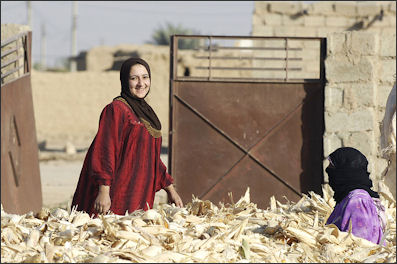
Iraqi women shuck corn for bread Between 2005 and 2008, the price of soy beans rose from $120 a ton to $462 a ton and wheat rose from $200 a ton to $386 a ton. Everything it seemed was affected. The price of corn went up because it suddenly was in demand as a biofuel. In 2007, about 25 percent of the total corn crop of the United States was used for biofuel. The demand for corn for biofuels helped boost corn prices to a record high of $288.10 per ton in June 2008. The price of meat, milk and eggs went up because the price of the feed that nourishes them went up. The price of food such as potatoes and barley that are not used in biofuels went up because of a supply shortage caused because land normally used to grow them was used to grow biofuel crops instead.
One of the main causes of the food crisis was a supply shortage that resulted as grain stockpiles dwindled to dangerously low levels as demand for grain outpaced supply for seven of nine years between 1999 and 2008. The low supply caused prices to rise. Joachim von Braun of the International Food Policy Research Institute in Washington D.C. told National Geographic, “Agricultural productivity growth is only one to two percent a year. This is too low to meet population growth and increased demand.”
Land that once supported the green revolution is now overworked and short of water. Tube wells and irrigation have lowered water tables and intensive agriculture has left some land with soil depleted by waterlogging and salinization. On top of that the intensive use of fertilizers and insecticide have poisoned drinking water supplies and caused increases in disease and cancer.
Longer term problems include the shrinking amount of arable land, soil degradation, erosion. Some have warned that rising food prices could result in an increase in the number of AIDS cases as poor women desperate for food turn to the sex trade to raise money to feed their families. Studies in Botswana, Malawi , Zambia and Tanzania have shown a link between food insecurity and transactional sex — trading sex for, fish, cooking oil or another food — among poor women.
Blame for the Global Food Crisis in 2008
The main culprits blamed for the 2008 food crisis were: 1) the sale of foodstuffs, namely corn and soy beans, to biofuel producers; 2) increased demand in places like China and India, where people were becoming richer and demanding more and better food like crop-consuming meat; 3) weather problems and droughts in break baskets like Ukraine and Australia as well in sub-Sahara Africa; 4) the high cost of fertilizer due to high oil prices; 5) hoarding of grains by nations wanting to ensure their domestic supplies stayed put; and 6) panic buying, hoarding and speculation.
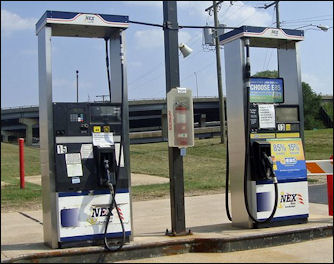
biofuel pumps
The United States, Japan and Europe were blamed for supporting high farm prices with subsidies and trade barriers that aided domestic farmers. The United States alone gives out billions of dollars in subsidies annually, including ones for the productions of biofuels. According to a World Bank development report agricultural subsidies in the developed world add up to $17 billion a year, many time more than what is given as foreign aid to the developing world.
European resistance to genetically-engineered crops was also blamed, as well as trade barriers that have implemented by a number of countries, including Argentina, Russia, Japan and South Korea. Speculators motivated by a weak dollar and low stock prices bought agricultural commodities as they did other commodities like oil and gold. The world price for commodities is often set as much by speculation as it is by production, demand and supply.
Shifting the production of crops to make biofuel rather than food has caused prices of some food stuffs to soar. When American farmers began switching from wheat to corn and soy beans to meet biofuel demands in the 2000s, corn prices tripled. The price of wheat went up as the supply was reduced. Prices for soy beans also soared as demand for it as a source of fuel rose. The ramifications were on a global scale: food riots in Mexico over corn price hikes, increased beer prices at Munich’s Oktoberfest and high soy prices in China and Japan. With soy prices so high palm oil became an attractive alternative.
See Separate Article BIOFUEL, BIODIESEL, BIOETHANOL factsanddetails.com
Aid Agencies and the Global Food Crisis
Some blamed the World Bank, the World Food Program and the U.N. Food and Agriculture Organization ( FAO) for not developing effective policies that could have prevented the food crisis from happening, with FAO being singled out as being particularly out of touch with today’s realities and problems. Senegal’s President Abdoulaye Wade called the FAO a wasteful “bottomless pit of money — and said it should be abolished for not helping to increase global food production.
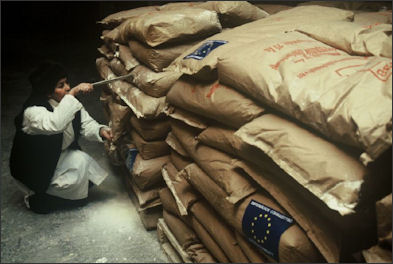
EU food aidUnited Nations Secretary General Ban Ki-Moon said, “This crisis did not come out of the blue. It grew out of more than a decade of neglect and ineffective policies. If not properly handled, this crisis could cascade into multiple crises affecting trade, development and even social and political security around the world.”
Peter Timmer, an expert on food security at Stanford University, told the Washington Post, “Everybody understands that 80 percent of the world’s poor are in rural areas.But the World Bank has basically said market signals don’t support agriculture. So we can’t support agriculture.” The World Bank’s Independent Evaluation Group has reported that total international agricultural aid fell from $1.9 billion in 1981 to less than $1 billion in 2001, and the number of agricultural specialists for Africa at the bank fell from 40 to 17 between 1998 and 2008.
The FAO defended itself by saying the crisis was largely caused by forces beyond its control such as population rises, increased consumption in China and India and the drive for more biofuels. The World bank responded with a proposal to boost annual lending for African agriculture from $450 million to $800 million and urged the United States, Japan and Europe to do end agricultural subsides that hurt poor farmers in the developing world.
Cheap Produce Prices and the Global Food Crisis
Felipe Fernandez-Armesto, author of “Food: A History”, wrote in the Times of London, “Ironically cheap food has been the main cause of the present shortages because it has made food production economically unattractive...The brief era of cheap eating has been a disaster for the world. People in the rich world have eaten too much food, fattening themselves into obesity and sickness in consequence...To make food cheap, we have poisoned farmland with chemicals, squandered precious water, abused marginal terrain and undermined biodiversity...Mass demand for cheap standard varieties helps strip traditional foods from green grocer shelves.Huge tracts of productive land were smothered for houses, industry and the curse of “leisure--really just a crass euphemism for mindless forms or expensive idleness.”
Between 1974 and 2005, food price s in the world market fell by three quarters in real terms. At the same time farming has been in decline, many farmers in the developing world have become worse off and the amount of perfectly fine edible food that is thrown away in the developed world has increased.
“Lower prices have impoverished farmers in the developing world.” Fernandez-Armesto wrote.” The poorest are locked into poverty — compelled in effect, to produce surpluses of cheap grains and forgo the traditional and rare crops that might command a decent price in a fussier, pricier world market. The green revolution suppressed such exotic crops as quinoa, tef and criollo potatoes — which the Western bourgeoisie is avidly rediscovering, now that they are rare and costly.”
One of the main forces behind the low food prices has been subsidies and trade restrictions in the developed world. The Economist reported: “Most of the subsidies and trade barriers have come at a huge cost. The trillions of dollars spent supporting farmers in rich countries have led to higher taxes, worse food, intensively farmed monocultures, overproduction and world prices that wreck the lives of poor farmers in the emerging markets. And for what? Despite the help plenty of Western farmers have been beset by poverty. Increasing productivity means you need fewer farmers, which steadily drives the least efficient off the land. Even a vast subsidy cannot reverse that.”
Response and Solutions to the Global Food Crisis

In June 2008, the United Nations convened an emergency meeting on the food crisis in Rome. Earlier the Rome-based World Food program, the world’s largest humanitarian organization, issued a plea to developed countries for more money and emergency supplies because soaring food costs had depleted it supplies and it was having to cut back rations for some of the world’s neediest countries in regions like Darfur and Myanmar, which had just been hit by a devastating cyclone.
The World Bank created a $1.2 billion fund to send speedy relief to victim of the food crisis, with $200 million in grants earmarked for people in desperate straights in poor countries, The bank said it would also increase support of agriculture by 50 percent to $6 billion and provide crop insurance and other assistance to small farmers in developing nations. Aid was allocated in the form of school meals, programs like food for work and providing farmers with seed and fertilizer.
Prices came back down during the global economic crisis in 2008 and 2009 but are expected to rise in the future. Rice that was selling for $1,080 a ton in April 2008 had dropped to $575 a ton by October.
Long term solutions to the global food problem include: 1) reaching an agreement on the World Trade Organization’s Doha Round trade liberalization talks; 2) abolishing food-export bans; 3) increasing investments in agricultural science and technology 4) liberalizing agricultural trade and reducing trade barriers; 5) doing sometimes about the biofuels problems; 6) deploying genetically-modified crops; 7) cracking down on speculators; 8) eating less meat; and 8) wasting less food and water.
Clearly more agricultural land is needed but such land is in short supply and it is being consumed by urbanization, development and industrialization. Also crop yields per acre need to be increased but this often requires more water and petroleum-based fertilization which are either expensive, in short supply, or use dwindling resources.
Felipe Fernandez-Armesto, author of “Food: A History”, wrote in the Times of London, “There are plenty of underexploited food resources, especially in the sea...If all else fails technology could turn plankton, insects and edible bacteria into something palatable.
Higher Food Prices in the Future?
In May 2011, Reuters reported: “Food prices could double in the next 20 years and demand will soar as the world struggles to raise output via a failing system, international charity Oxfam said on Tuesday, warning of worsening global hunger. "The food system is pretty well bust in the world," Oxfam Chief Executive Barbara Stocking told reporters, announcing the launch of the Grow campaign as 925 million people go hungry every day. "All the signs are that the number of people going hungry is going up," Stocking said. [Source: David Brough, Reuters, May 31, 2011]
Hunger was increasing due to rising food price inflation and oil price hikes fueled by speculators, scrambles for land and water, and creeping climate change, Oxfam said. Food prices are forecast to increase by something in the range of 70 to 90 percent in real terms by 2030 before taking into account the effects of climate change, which would roughly double price rises again, Oxfam said.
Josef Schmidhuber, deputy director of the statistics division of the U.N. Food and Agriculture Organization (FAO), said he broadly agreed with the message of the Oxfam report but disagreed with Oxfam's long term food price forecast. "I would not think that food prices would rise rapidly in real terms if there were no real increase in oil prices," Rome-based Schmidhuber said. "I wouldn't say that our food system is broken. The world will always be able to produce enough food."
Agriculture Crisis in the Future?
Future crisis in agriculture Oxfam warned that by 2050 demand for food will rise by 70 percent yet the world's capacity to increase production is declining. The average growth rate in agricultural yields has almost halved since 1990 and is set to decline to a fraction of one percent in the next decade while increasing regional and local crises could double the need for food aid in the next 10 years. [Source: David Brough, Reuters, May 31, 2011]
"Now we have entered an age of growing crisis, of shock piled upon shock: vertiginous food price spikes and oil price hikes, devastating weather events, financial meltdowns and global contagion," Oxfam said in a report. "The world's poorest people, who spend up to 80 percent of their income on food, will be hit hardest."
Entitled "Growing a Better Future: Food Justice in a Resource-Constrained World," the report said: "The scale of the challenge is unprecedented, but so is the prize: a sustainable future in which everyone has enough to eat."
Oxfam believes one way to tame food price inflation is to limit speculation in agricultural commodity futures markets. It also opposed support for using food as a feedstock for biofuels. "Financial speculation must be regulated, and support dismantled for biofuels that displace food," it said. Stocking said she favored the introduction by regulators of position limits in agricultural commodities futures trading, noting that financial speculation aggravated price volatility.
Fighting poverty is the key to relieving hunger, said Martin Mortimer, director of the University of Liverpool's Food Security Network. "This report from Oxfam re-emphasizes the need to address food security in the context of poverty alleviation," he said. The report said the shortcomings of the food system flowed from failures of government to regulate and to invest, which meant that companies, interest groups and elites had been able to plunder resources.
Efforts to Combat High Food Prices Are Often Counterproductive
Jeffrey Frankel wrote in the Christian Science Monitor, “There is a long history of measures aimed at reducing commodity-price volatility that have ended up doing more harm than good.
For example, some inflation-targeting central banks have reacted to increases in prices of imported commodities by tightening monetary policy and thereby increasing the value of the currency. But adverse movements in the terms of trade must be accommodated; they cannot be fought with monetary policy. [Source: Jeffrey Frankel, Project Syndicate, June 27, 2011. Jeffrey Frankel is Professor of Government at Harvard University's John F. Kennedy School of Government. ]
Producing countries have also tried to contain price volatility by forming international cartels. But these have seldom worked. In theory, government stockpiles might be able to smooth price fluctuations. But this depends on how stockpiles are administered. The historical record is not encouraging. In rich countries, where the primary producing sector usually has political power, stockpiles of food products are used as a means of keeping prices high rather than low. The European Union’s Common Agricultural Policy is a classic example — and is disastrous for EU budgets, economic efficiency, and consumer pocketbooks.
In many developing countries, on the other hand, farmers lack political power. African countries adopted commodity boards for coffee and cocoa. Although the original rationale was to buy the crop in years of excess supply and sell in years of excess demand, thereby stabilizing prices, in practice the price paid to cocoa and coffee farmers, who were politically weak, was always below the world price in the early decades of independence. As a result, production fell.
Politicians often seek to shield consumers through price controls on staple foods and energy. But artificially suppressing prices usually requires rationing to domestic households. (Shortages and long lines can fuel political rage just as surely as higher prices can.) Otherwise, the policy satisfies the excess demand via imports, and so raises the world price even more.If the country is a producer of the commodity in question, it may use export controls to insulate domestic consumers from increases in the world price. In 2008, India capped rice exports, and Argentina did the same for wheat exports, as did Russia in 2010.
Export restrictions in producing countries and price controls in importing countries both serve to exacerbate the magnitude of the world price upswing, owing to the artificially reduced quantity that is still internationally traded. If producing and consuming countries in grain markets could cooperatively agree to refrain from such government intervention — probably by working through the World Trade Organization — world price volatility might be lower.
Dealing with High Food Prices
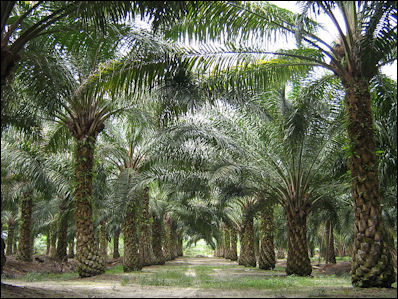
Oil palms in Malaysia French President Nicolas Sarkozy has campaigned for tough measures to limit speculation in agriculture commodity markets. In June 2011, Reuters reported that G20 farm ministers reached to tackle high food prices, agreeing to a watered-down declaration that fell short of ambitious proposals by some countries to tighten regulation of commodity markets. [Source: Reuters, June 23, 2011]
Jeffrey Frankel wrote in the Christian Science Monitor, “In the meantime, some obvious steps should be taken. For starters, bio-fuel subsidies should be abolished. Ethanol subsidies, such as those paid to American corn farmers, do not accomplish policymakers’ avowed environmental goals, but do divert grain and thus help drive up world food prices. By now this should be clear to everybody. But one cannot really expect the G-20 agriculture ministers to be able to fix the problem. After all, their constituents, the farmers, are the ones pocketing the money. (The US, it must be said, is the biggest obstacle here.) [Source: Jeffrey Frankel, Project Syndicate, June 27, 2011.]
It is probably best to accept that commodity prices will be volatile, and to create ways to limit the adverse economic effects — for example, financial instruments that allow hedging of the terms of trade. What the G-20 agriculture ministers have agreed is to forge a system to improve transparency in agricultural markets, including information about production, stocks, and prices. More complete and timely information might indeed help.
But the broader sort of policy that Sarkozy evidently has in mind is to confront speculators, who are perceived as destabilizing agricultural commodity markets. True, in recent years, commodities have become more like assets and less like goods. Prices are not determined solely by the flow of current supply and demand and their current economic fundamentals (such as disruptions from weather or politics). They are increasingly determined also by calculations regarding expected future fundamentals (such as economic growth in Asia) and alternative returns (such as interest rates) — in other words, by speculators.
But speculation is not necessarily destabilizing. Sarkozy is right that leverage is not necessarily good just because the free market allows it, and that speculators occasionally act in a destabilizing way. But speculators more often act as detectors of changes in economic fundamentals, or provide the signals that smooth transitory fluctuations. In other words, they often are a stabilizing force...Shooting the messenger is no way to respond to the message.
Image Sources: Wikimedia Commons
Text Sources: New York Times, Washington Post, Los Angeles Times, Times of London, Yomiuri Shimbun, The Guardian, National Geographic, The New Yorker, Time, Newsweek, Reuters, AP, Lonely Planet Guides, Compton’s Encyclopedia and various books and other publications.
Last updated January 2012

